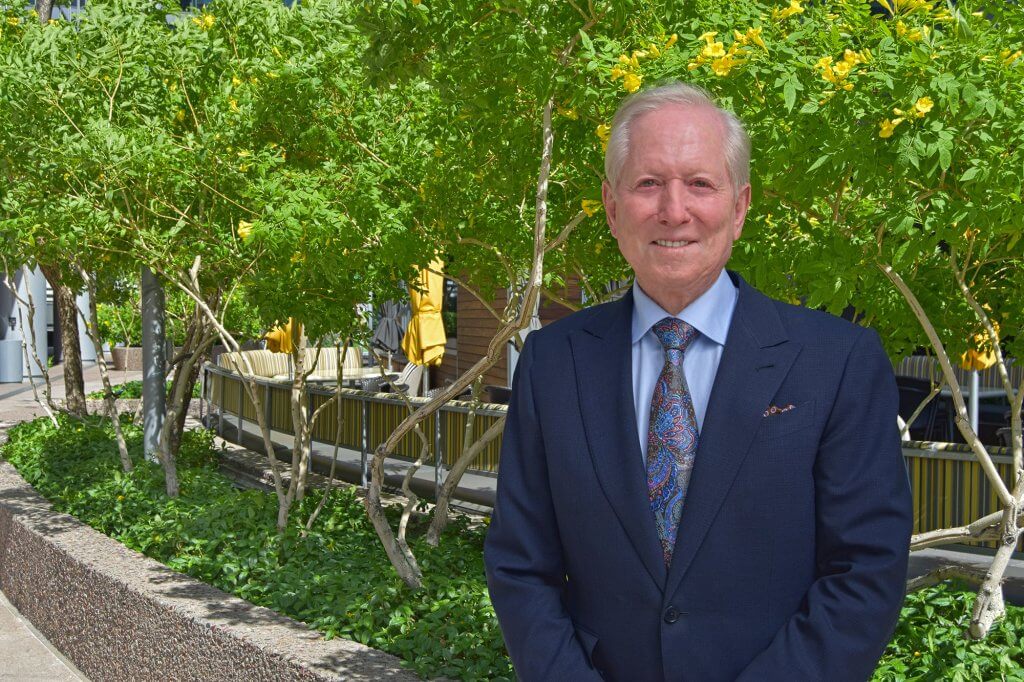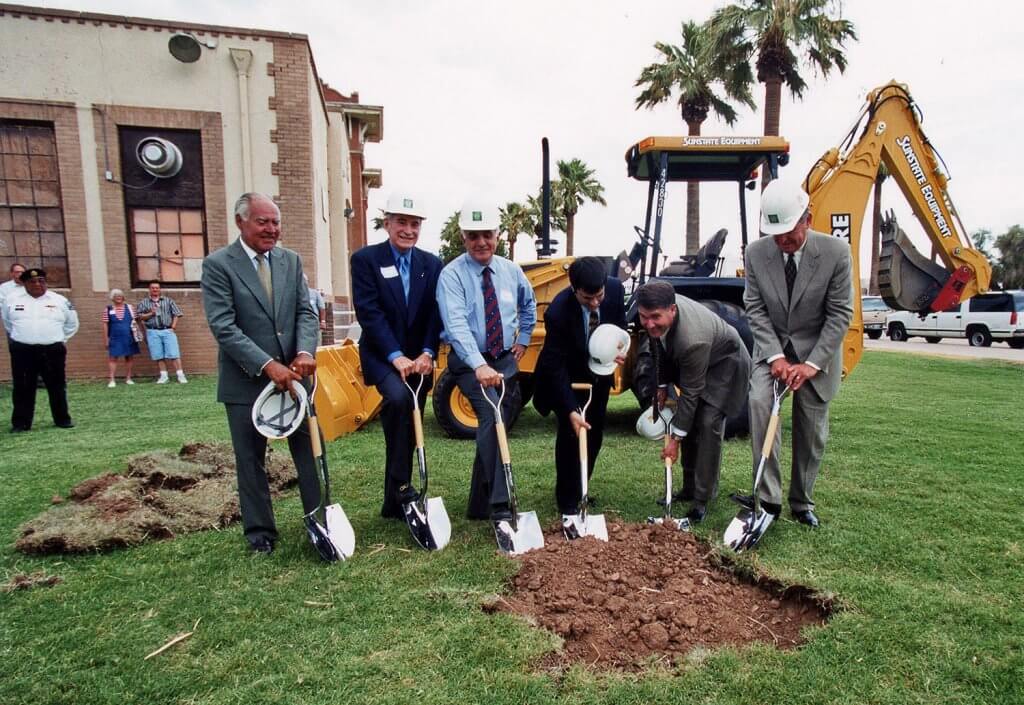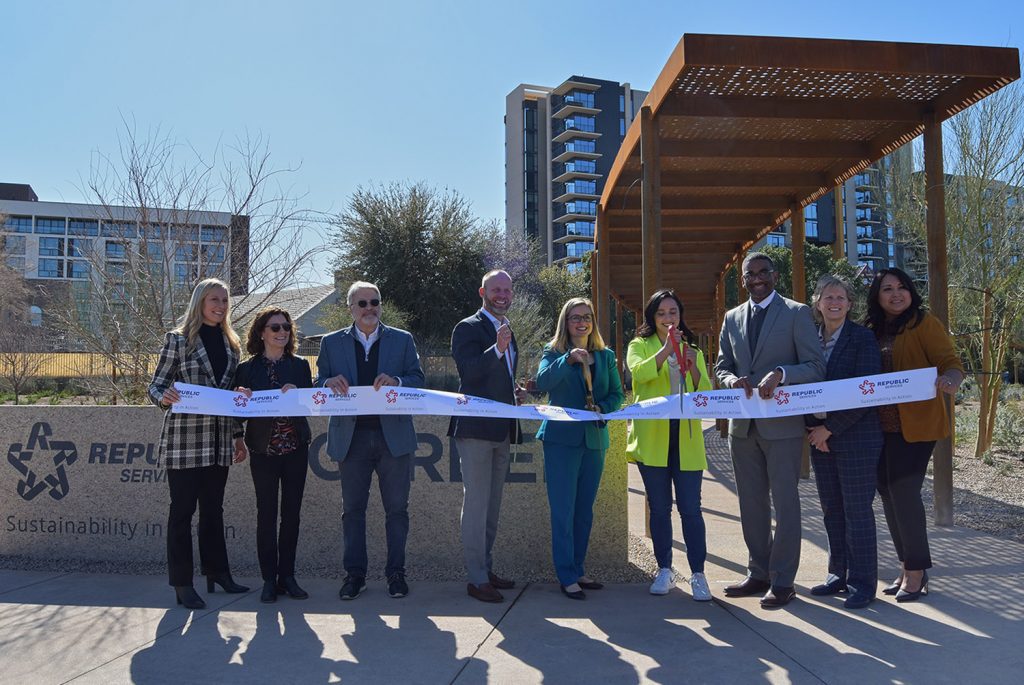There’s no place Larry Lazarus would rather be than Phoenix.
In the early 1970s, Lazarus relocated to Phoenix from Chicago. He began as a neighborhood activist, advocating for city services for the Paradise Valley area.
His advocacy put him into the orbit of Phoenix Mayor Margaret T. Hance, who became a mentor to the young zoning attorney. Eventually, she used his expertise as Chairman of the Urban Forms Direction Committee.
The results of the committee still shape how the City of Phoenix approaches growth and development. With an emphasis on self-sufficient local communities or villages, the plan prepared Downtown for future growth.
With aspirations of a vibrant Downtown, his path inevitably crossed with Phoenix Community Alliance. More than 40 years of experience have influenced initiatives, including fundraising for Steele Indian School Park, the creation of the Human Services Campus, and, currently, fundraising for the Margaret T. Hance Park Revitalization Project.
Phoenix Community Alliance was built on the foundation of industry professionals who all shared the same goal: to use their expertise to benefit the Greater Downtown Phoenix community.
The “City-Shaper” series shares historical knowledge of influential PCA Members and their influence on the growth of Downtown for the last 40 years.

Hance Park Fundraising Co-Chair Larry Lazarus pictured outside the Downtown Phoenix, Inc./Phoenix Community Alliance offices. (Photo by Taylor Costello)
Q: What factors first made you interested in Downtown?
Lazarus: I became interested in Downtown because no residential developments were in the immediate area.
It was a 9 to 5 place. When it got dark, it was dangerous. I remember going back and forth to fundraisers in the evening, and you had to be careful who was walking behind you.
Urban planning has been one of my loves. My law firm was very active politically. We were also the first ones as zoning attorneys to go into the neighborhood [to conduct community outreach for projects].
One of my mentors, [developer] Rusty Lyon, helped influence that. He said, “We have no problem meeting with the neighborhood because we think we have a good project.”
That’s how I got involved with PCA [too]. I think I’m the only zoning attorney who started as a neighborhood activist.
Q: How City of Phoenix handled growth and development was influenced by a group you chaired in the late 1970s called the Urban Forms Direction Committee. What were the origins of that?
Lazarus: My mentor [Mayor] Margaret Hance created a group to determine how the City of Phoenix should grow. Around that time, I also met [future PCA Chair] Marty Shultz [who was her Chief of Staff at the time.]
She organized a two-day retreat with the City’s Planning Commission in Carefree, Arizona. They brought community leaders, businessmen, political leaders, and professional planners to study how we grow sustainably as a city, and we looked at various alternatives. The Village Concept Plan was the one that won out.
By the late 1970s, the City of Phoenix exploded with exponential growth without a long-term plan to limit the effects of urban sprawl, in which residents traveled further distances by automobile.
The Village Concept Plan is defined by different villages within the City of Phoenix, with a proportionate amount of people living and having the opportunity to work and play in each village. All have a town center, or the core, with the highest density and activity that becomes less dense the further it is from the center.
These less dense areas are generally neighborhoods near natural or manmade environments, such as canals, preserves, or freeways. Eventually, Village Planning Committees around the city formed to check growth through the plan’s virtues.
In early 1980, the City of Phoenix was recognized with the All-American City Award by the National Municipal League for this five-year study.
In 1981 there were five Village Planning committees; today, that number has grown to fifteen.
The Village Concept Plan had a significant effect on Downtown development. Downtown was a super-core, but there was virtually no residential.
The super-core accommodated things no other corridor had, like sports venues, health care and research, major corporations, local Government, and all the major arts.
We needed to preserve nearby historic neighborhoods, attract new residents to work and live Downtown, and eliminate urban sprawl.

In early 1980, the City of Phoenix was recognized with the All-American City Award by the National Municipal League for this five-year study. (Clipping courtesy of The Arizona Republic Archives)
Q: Could you describe your role in forming the Human Services Campus? As a zoning attorney, you helped assist with variances or other technical issues to make the plans possible.
Lazarus: The unsheltered population was becoming an issue here before it became a national issue throughout the country.
Mo [Stein], Marty [Shultz], and Jerry [Colangelo] recognized this would be an issue. What happened was that the service organizations for the unsheltered population were siloed. And they weren’t talking to each other.
Marty approached me and said, “Larry, here’s the project. Here’s what we’re trying to do. Will you help?” And I said, “Yes, how can I help?” And he asked me to donate my zoning and land use expertise pro bono.
And you don’t say “no” to Marty Shultz.
He brought them together to coordinate, not only to provide services locally but also a model nationally. He was really the linchpin that made this happen.
And we’re still working on that. It’s a major problem because we need to have enough affordable housing.
The thing about our group is that different people have different ideas, and you don’t have to take the lead every time. Sometimes it comes from Marty; sometimes, it’ll come from Mo; sometimes, it comes from me. And now it’s coming from our Committee Chairs, and it’s coming from Devney [Majerle].
You can’t be jealous that it’s not your idea. You’ve got to understand it’s a good idea, and you don’t have to be the lead.
People who wait to take credit don’t get anything done. Jump on, and work on it.

The ground-breaking ceremony for Steele Indian School Park was held in 2000. (Photo courtesy of the PCA Archives)
Q: Seven years ago, the PCA board determined they would step in to help fundraise for the revitalization of Hance Park, which would realize the City of Phoenix’s masterplan for the park and Downtown. How did you know that the park needed PCA’s attention?
Lazarus: Every major city has a great downtown park. We were experiencing substantial growth and needed a park to accommodate residents and their families. We also wanted an environment that could host national events like the Super Bowl and Final Four.
We needed an iconic gathering place.
Mo [Stein] and I talked about it quite a bit before the board’s decision [to form the Hance Park Fundraising Committee]. Mo was in a leadership position to lead the dialogue within PCA. I think [Hance Park Revitalization Co-Chair] Tim [Sprague] and I raised our hands to volunteer for the positions.
PCA was a natural choice because we had a vested interest in Downtown and had previous experience raising money for Steele Indian School Park. Through Jerry Colangelo, at the time, we were the ones who led the fundraising efforts for the business and philanthropic communities.
After the City of Phoenix obtained the prime acreage in an unusual three-way land swap, Longtime PCA President Barry Starr urged Mayor Paul Johnson to turn the underserved parcel into a signature city park.
The park is named for Horace Steele, a local businessman who made a significant donation to construction costs. On November 10, 2001, Steele Indian School Park opened. The community features included pathways for pedestrians and bicyclists, a grassy amphitheater for concerts, artistic water features, and preserved historic buildings from its previous life as a school. Today the park hosts many large annual events, including Fabulous Phoenix 4th and Phoenix Pride Festival.
Our membership experience was with neighbors, the business community, and the arts. A lot of these things were happening around Hance Park. It made sense from a membership and experience standpoint to be there.
Not only that but Tim [Sprague] and Members have developed business relationships over 40 years with CEOs of major corporations. I’m a member of Greater Phoenix Leadership and actively work with the CEOs of major corporations on public policy. We were also involved with philanthropic organizations. We had relationships so that we could approach these leaders.
It became more difficult for relationship-building during the pandemic. But we’re now back on track.

City of Phoenix officials, Republic Services, and community leaders celebrated the unveiling of the Republic Services Garden at Margaret T. Hance Park, pictured Wednesday, February 1, 2023. (Photo by Taylor Costello)
Three years after the Pandemic, Lazarus describes the current status of the PCA Hance Park Fundraising Committee as “starting to get our legs again.”
Margaret T. Hance Park was the destination for tens of thousands of concertgoers when it served as the venue for the Super Bowl Experience over three days in February.
With multiple sponsorships, in the form of Fiesta Bowl’s $2 million toward an interactive play area, Republic Service’s $2 million for the new garden, and a seven-figure donation from APS, Phase One is well on its way!
Phase One is a $45 million project focused on fully developing the Canyon area, which straddles the center of the park, levered on Central Avenue. Elements of Phase One include Fiesta Bowl Play, Republic Services Garden, family-friendly landmarks, open green spaces, tree groves, other shading, and a splash pad for kids.
The Fundraising Committee is actively meeting with foundations and other local corporations, who invest in our community in impactful ways, to make Hance Park the next great city park — a welcoming and inclusive gathering place for the region.
Everyone, including Mayor Gallego, Phoenix City Council, City of Phoenix Parks & Recreation Department, and Hance Park Conservancy, is on the same page about the public good they’re shepherding.
All of this continues to be gratifying work for someone who arrived from the Midwest five decades prior and immediately found an accepting community open to implementing good ideas.
But, as he describes it, “You don’t have to be in Phoenix for three or four generations before you can have an impact in the community.”

Larry Lazarus and Past Board Chairs Marty Shultz and Mo Stein pictured Thursday, March 23, 2023, during the PCA Quarterly Member Meeting at the Children’s Museum of Phoenix. (Photo by Taylor Costello)






